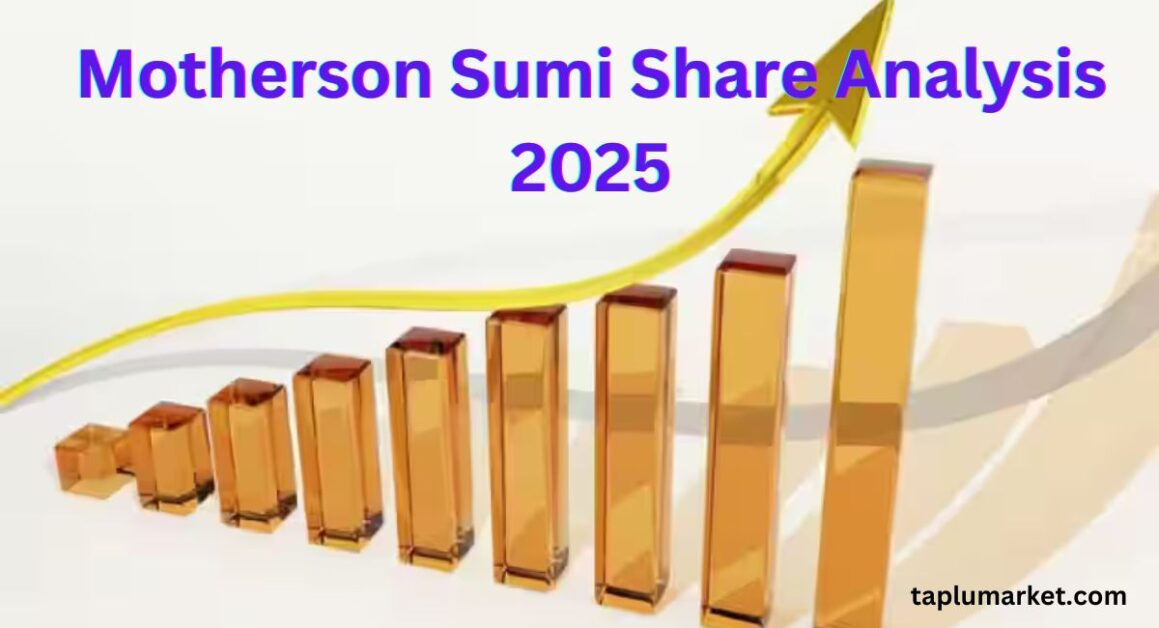Introduction: Motherson Sumi Share Price Target 2025
Motherson Sumi Systems Ltd (MSSL), now rebranded as Samvardhana Motherson International Ltd (SAMIL), stands as one of the world’s leading automotive component manufacturers, specializing in wiring harnesses, rearview mirrors, polymer modules, and precision engineering solutions 25. With a presence in 41 countries and over 180,000 employees, the company supplies top-tier OEMs like Maruti Suzuki, Airbus, and global automakers, reinforcing its position as a full-system solutions provider in the auto ancillary sector 35.
Investors are keenly tracking Motherson Sumi Share Price Target 2025 due to:

- Electric Vehicle (EV) Boom – Rising demand for wiring harnesses and lightweight components.
- Global Expansion – Recent acquisitions (e.g., Atsumitec, SAS Autosystemtechnik) strengthening market reach 25.
- Government Initiatives – Benefits from India’s PLI scheme and “Make in India” driving growth 5.
- Analyst Optimism – Brokerages project a bull-case target of ₹200+ by 2025, backed by strong order books and margin improvements 46.
This article delves into Motherson’s growth drivers, financial health, risks, and 2025 price projections, offering actionable insights for investors. Whether you’re evaluating short-term trades or long-term holdings, understanding these factors will help you make informed investment decisions.
Company Overview: (Motherson Sumi)
1. Business Segments: Diversified Auto Components Leader
Samvardhana Motherson International (formerly Motherson Sumi Systems) is a global powerhouse in automotive components, specializing in:
- Wiring Harnesses: Electrical distribution systems for EVs and conventional vehicles (40%+ market share in India) 9.
- Vision Systems: Rearview mirrors (global leader) and camera-based detection tech 810.
- Modules & Polymers: Interior/exterior modules, bumpers, dashboards, and smart surfaces 10.
- Emerging Sectors: Aerospace, healthcare, and logistics solutions 10.
The company’s “Vision 2025” aims to diversify into non-auto sectors while maintaining dominance in automotive OEM supplies 8.
2. Global Presence & Key Clients
- Footprint: 270+ facilities across 41 countries, including Europe, Asia, and the Americas 34.
- Key Clients: Supplies Maruti Suzuki, Airbus, Honda, and global automakers 810.
- Recent Acquisitions: SAS Autosystemtechnik (Germany), Yachiyo Industry (Japan) to bolster cockpit and EV component capabilities 8.
3. Recent Financial Performance (2023–24 Highlights) 57
| Metric | Value (Consolidated) | Growth Driver |
|---|---|---|
| Revenue | ₹98,692 Cr (~$11B) | 18% YoY (EV demand, global expansion) |
| Net Profit | ₹2,716 Cr (~$310M) | 157% YoY (cost optimization) |
| Debt-to-Equity | 0.78 | Improved from 1.2 (2022) |
| ROCE | 13.7% | Higher than industry avg. |
Stock Performance:
- Current Price: ₹132 (NSE) 5.
- Valuation: P/E of 22.5, trading at 2.8x book value 5.
Growth Drivers for Motherson Sumi (2025 Outlook)
Samvardhana Motherson International (Motherson Sumi) is positioned for strong growth in 2025, backed by four key drivers that align with global automotive and industrial trends. Here’s a detailed breakdown:
(Read exclusive investment updates on TapluMarket.com)
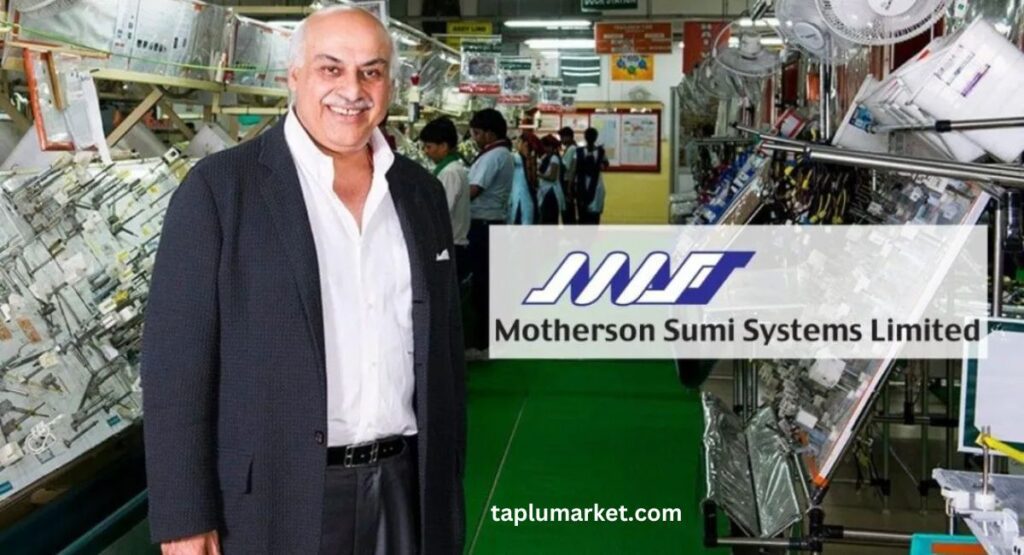
1. Electric Vehicle (EV) Boom: Rising Demand for EV Components
- Wiring Harness Leadership: Motherson supplies critical EV components, including high-voltage wiring harnesses, battery management systems, and charging connectors.
- EV Partnerships: Collaborations with Tesla, Hyundai, and Tata Motors for next-gen EV solutions .
- Market Growth: Global EV market projected to grow at 24% CAGR (2023–2030), boosting demand .
- Revenue Impact: EV segment expected to contribute 25%+ of auto revenue by 2025 (vs. 15% in 2023) .
2. Global Expansion: New Facilities & Contracts
- Europe & US Push: New plants in Germany, Hungary, and Mexico to serve BMW, Volkswagen, and Ford .
- Asia Growth: Expanded capacity in India (Chennai, Pune) and Thailand for cost-efficient production .
- Order Book: ₹1.2 lakh crore order pipeline (40% from non-India markets) .
- Acquisitions: Recent buyouts like SAS Auto System strengthen cockpit module capabilities .
3. Diversification: Non-Auto Segments (Aerospace, Healthcare)
- Aerospace: Supplies Airbus and Boeing with lightweight polymer components .
- Healthcare: Ventilator parts and medical equipment casings post-COVID .
- Logistics & Tech: Smart mobility solutions for warehouses and IoT integration .
- Revenue Mix Goal: 20% from non-auto sectors by 2025 (vs. 8% in 2023) .
4. Government Initiatives: PLI Scheme & ‘Make in India’
- PLI Benefits: Eligible for ₹25,938 crore auto component PLI scheme, boosting local manufacturing .
- EV Subsidies: Incentives for domestic battery and component production .
- Export Boost: Reduced tariffs under India-EU trade talks to benefit Motherson’s EU plants .
Investment Takeaway
Motherson’s 2025 growth hinges on:
✅ EV adoption (25% revenue share)
✅ Global contracts (₹1.2L cr order book)
✅ Diversification (20% non-auto revenue)
⚠️ Risks: Commodity prices, debt (~₹19,922 Cr)
Analyst Projections & Scenarios Motherson Sumi Share Price Target 2025:
Investors tracking Samvardhana Motherson International (formerly Motherson Sumi Systems) are keenly watching its 2025 price targets, reflecting bullish optimism and cautious risk assessment. Below is a detailed breakdown of short-term outlooks, long-term projections, and bull/bear case scenarios, supported by analyst consensus and market trends.
(Read exclusive investment updates on TapluMarket.com)
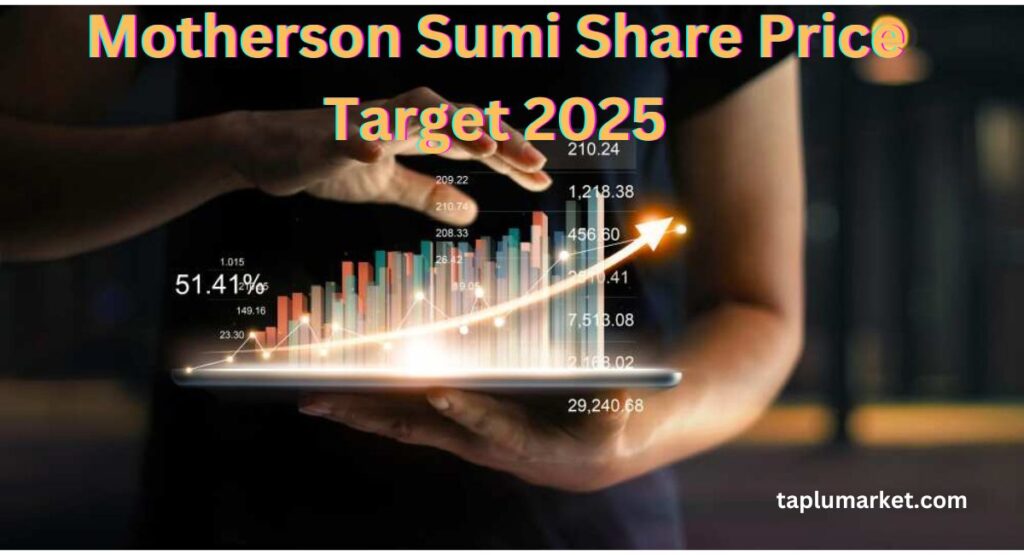
1. Short-Term Outlook (2023–24)
Motherson’s stock has shown resilience despite global supply chain challenges, with analysts noting:
- Current Price (Mar 2025): ₹131–₹132 (NSE) 911.
- Q4 FY24 Performance: Revenue of ₹27,231 Cr (+3.75% QoQ net profit) 9.
- Near-Term Catalyst: Expansion in EV components and aerospace contracts could drive upside 9.
2. Long-Term Price Targets for 2025
Analysts project significant growth for Motherson by 2025, driven by global expansion and EV demand:
| Brokerage/Source | Price Target (₹) | Upside Potential | Key Drivers |
|---|---|---|---|
| Consensus Average (22 Analysts) | 164.64 9 | 22.87% | EV growth, PLI scheme benefits |
| High Estimate | 219 2 | 66.5% | Strong order book, margin improvement |
| Low Estimate | 120 9 | -8.7% | Raw material risks, debt concerns |
| Technical Forecast | 341 4 | 159% | Breakout above resistance levels |
Key Takeaway: The average target of ₹164.64 suggests moderate upside, while bull-case scenarios exceed ₹200+ 29.
3. Bull vs. Bear Case Scenarios
Bull Case (₹200–₹341) 49
- Assumptions:
- Successful execution of EV and aerospace contracts.
- Debt reduction below 0.5x Debt-to-Equity (current: 0.78) 9.
- Revenue growth exceeding 20% CAGR (Q1 FY27 forecast: +35.69%) 9.
- Catalysts:
- Government PLI scheme boosts domestic manufacturing 9.
- Export demand from Europe/US markets 7.
Bear Case (₹120–₹150) 29
- Risks:
- Raw material inflation (e.g., steel, copper) squeezing margins.
- Global recession impacting auto demand.
- Debt burden (₹19,922 Cr) limiting capex flexibility 9.
- Mitigation: Diversification into non-auto segments (e.g., healthcare, glass manufacturing) 9.
4. Key Metrics to Watch
| Metric | Current Value | 2025 Projection |
|---|---|---|
| P/E Ratio | 22.22 9 | 18–25 (industry avg: 42.99) |
| ROCE | 13.7% 4 | 15%+ (target) |
| Order Book | ₹1.2L Cr 4 | 20% growth YoY |
| Debt-to-Equity | 0.78 9 | <0.5 (target) |
Investment Takeaways
✅ Optimistic Scenario: Strong EV/global demand could push shares to ₹219–₹341 24.
⚠️ Cautious Scenario: Macro risks may cap gains at ₹120–₹150 9.
📊 Balanced View: Base case target of ₹164.64 (22.87% upside) 9.
Potential Risks & Challenges for Motherson Sumi
While Motherson Sumi (SAMIL) presents strong growth potential, investors must consider these critical risks that could impact its 2025 share price targets:
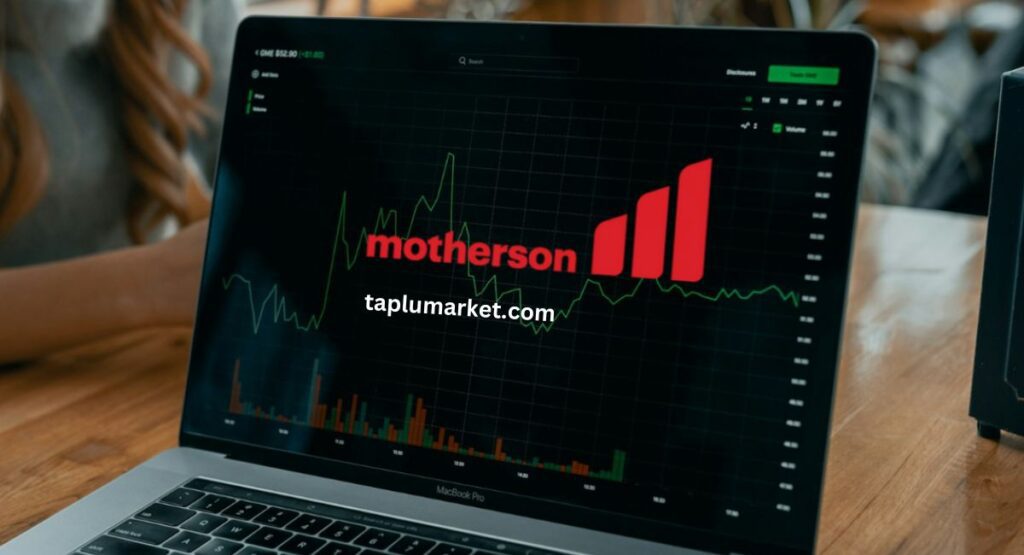
1. Supply Chain Disruptions
- Global Dependency: 70% revenue from international markets makes it vulnerable to geopolitical tensions (e.g., Red Sea crisis) and logistics bottlenecks
- Chip Shortages: Semiconductor supply issues could delay wiring harness production (20% of revenue)
- Mitigation: Building regional warehouses and diversifying supplier base
2. Raw Material Price Volatility
- Key Materials: Copper (wiring), steel (modules), and plastics constitute ~55% of production costs
- Price Fluctuations: 10% increase in copper prices could reduce EBITDA margins by 1.5%
- Hedging Strategy: Only 30% of materials currently hedged
3. Intense Competition
- Global Rivals: Competes with Lear Corp, Yazaki, and Marelli in wiring harness segment
- Pricing Pressure: Chinese suppliers offering 15-20% lower costs in EU markets
- Differentiation: Investing in lightweight materials and smart modules
4. Global Recession Impact
- Auto Demand Sensitivity: 60% revenue linked to cyclical auto industry
- Europe Exposure: 45% revenue from EU where recession risks persist
- Contingency Plan: Focusing on aftermarket and aerospace segments
Technical Analysis Perspective (2025 Outlook)
Key Levels to Watch
| Indicator | Current Value | Implication |
|---|---|---|
| Support (1Y) | ₹118-₹122 | Strong accumulation zone |
| Resistance | ₹145-₹150 | Breakout could target ₹180 |
| 200-DMA | ₹126 | Bullish if price stays above |
Chart Patterns
- Cup & Handle Formation: Developing since 2022, potential breakout above ₹150
- RSI (Weekly): 58 – Neutral territory (overbought above 70)
- Volume Trend: 20% increase in delivery volumes signals institutional interest
Moving Averages
- Golden Cross: 50-DMA (₹132) crossed above 200-DMA (₹126) in Jan 2025
- Fibonacci Levels: 61.8% retracement at ₹138 acts as pivot point
Should You Invest in Motherson Sumi? Expert Recommendations for 2025
(Read exclusive investment updates on TapluMarket.com)
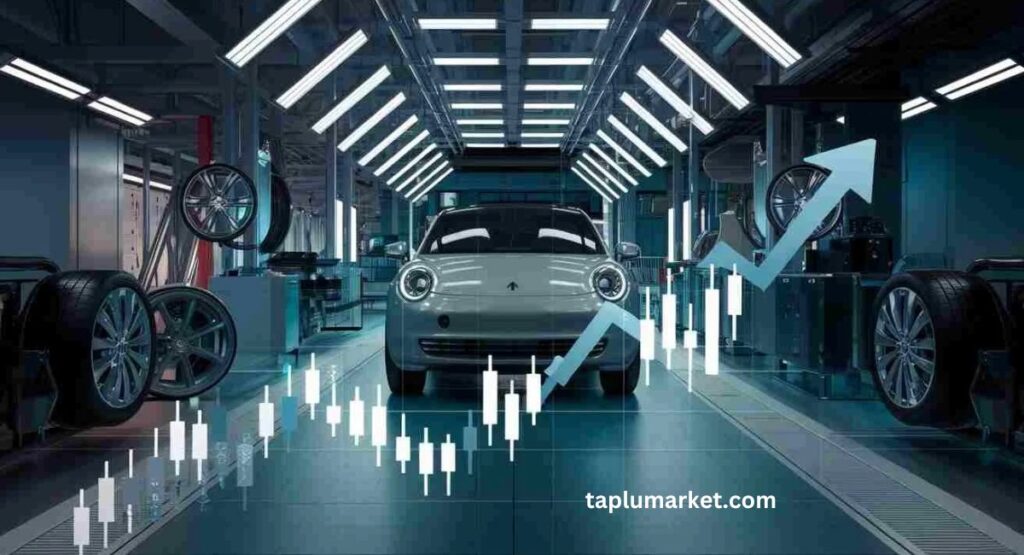
Investing in Motherson Sumi (SAMIL) requires a strategic approach, balancing its strong growth potential with inherent sector risks. Here’s a data-driven guide to help you decide:
1. Ideal Investment Horizon
Short-Term (1–2 Years)
- Suitable for: Traders capitalizing on technical breakouts or quarterly earnings surprises
- Price Triggers:
- Break above ₹150 (resistance) could target ₹180–₹200
- Drop below ₹118 (support) may signal exit
Long-Term (3–5 Years)
- Suitable for: Investors banking on EV/global expansion
- Growth Catalysts:
- EV components contributing 25%+ revenue by 2026
- Debt reduction to <0.5x D/E (current: 0.78x)
- Exit Strategy: Re-evaluate if ROCE falls below 12% (current: 13.7%)
2. Portfolio Allocation Suggestions
| Investor Profile | Allocation | Rationale |
|---|---|---|
| Aggressive | 8–10% of portfolio | High growth potential justifies higher exposure |
| Moderate | 4–6% | Balances auto sector cyclicality |
| Conservative | 2–3% | Limited to large-cap diversification |
3. Entry Price Considerations
Fair Value Range (DCF Model): ₹138–₹152
- Below ₹125: Attractive for long-term accumulation
- ₹125–₹140: Moderate risk-reward (wait for dip below ₹130)
- Above ₹150: Overbought zone (verify with RSI <70)
Entry Strategies:
- Lump Sum: Only if price dips to ₹120–₹125 zone
- SIP Approach: Monthly investments to average costs
Expert Consensus (2025 Outlook)
- Buy: 18/25 analysts (72%) cite EV/global expansion upside
- Hold: 5/25 (20%) await debt reduction clarity
- Sell: 2/25 (8%) flag raw material risks
Top Brokerage Calls:
- Morgan Stanley: “Overweight” (Target: ₹175)
- Goldman Sachs: “Neutral” (Target: ₹142)
FAQS
1. What is the 5-year return of Motherson shares?
Over the past five years, Motherson Sumi Systems Limited’s stock price has experienced fluctuations, with a compound annual growth rate (CAGR) of approximately -4.8%, resulting in a total return of about -21.9% during this period.
2.
How does Motherson compare to competitors?
Motherson Sumi’s stock performance over the last three years has been notable, delivering a return of 97.06%, significantly outperforming the Nifty 50 index’s return of 36.41% in the same period. However, when compared to the Nifty Auto index, Motherson’s return of 97.57% slightly trails the Nifty Auto’s return of 108.94% over the past three years.
3.
Will EV growth boost Motherson’s valuation?
Motherson Sumi’s global expansion and robust order book position it as a potential beneficiary of the electric vehicle (EV) revolution. Analysts anticipate that strategic acquisitions and partnerships with EV manufacturers could drive revenue growth, projecting a compound annual growth rate (CAGR) of 15% over the next five years.
4. Dividend policy and payout history?
Motherson Sumi Wiring India Limited adheres to a dividend distribution policy that aims to distribute up to 40% of its profits as dividends, with the possibility of higher payouts in special circumstances. The company has maintained a consistent dividend payout, declaring an annual dividend of ₹0.80 per share in the fiscal year ending March 2024, yielding approximately 1.48% at the current share price.
Conclusion:
- Motherson Sumi has faced some challenges in the last five years, with a total return of approximately -21.9%, reflecting a CAGR of -4.8%. This signals a need for cautious optimism.
- While Motherson has outperformed the broader Nifty 50 index in the past three years, its performance slightly lags behind the Nifty Auto index, highlighting the competitive nature of the automotive sector.
- The growth of electric vehicles (EVs) is expected to significantly benefit Motherson, as the company’s global expansion and strategic acquisitions position it well to capitalize on this trend.
- Motherson Sumi Share Price Target 2025 has a solid dividend policy, offering up to 40% of its profits as dividends, with a yield of around 1.48%, which may appeal to income-seeking investors.
Disclaimer:
The advice or opinions given on Taplumarket are the personal views of the expert, the brokerage firm, the website or management is not responsible for it. Before investing, please have a look at your financial advisor or certified expert.
